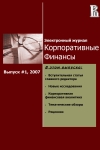Attempting to solve the capital structure mystery: a behavioral approach
Abstract
Originally, the neoclassics declared the capital structure problem unsolvable. In 2007 edition of Principles of Corporate Finance, Myers proclaimed the problem solved. Nevertheless, empirical tests of neoclassical (or traditional) theories have demonstrated that new explanations are required. Empirical data have indicated that companies somehow do not implement the optimal capital structure despite the trade-off theory predicting it would lead to company value increase. Conversely, the company allows the debt-to-equity ratio to drift, copies the capital structure from other companies in the same industry, or stays completely debt free and tops the lists of world best companies. Perhaps, other reasons drive the actual decisions on capital structure. Therefore, the following questions arise: Why the capital structure is set the way it is? How to model it? These are the new questions that behavioural finance paradigm is trying to find the answers for. Departure from the traditional economic rationality and incorporation of a psychological man into the equation have brought noteworthy results. Behavioural finance scientists have created a number of theories, such as market timing, informational cascades theory, managerial investment autonomy theory and concepts of managerial traits influence on capital structure decisions. The article discusses three stages of moving from traditional to behavioural paradigm: empirical challenges for traditional capital structure theories, review of a number of influential studies of capital structure, and relevant behavioural finance theories.

